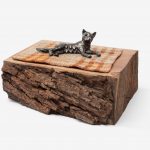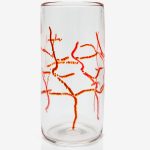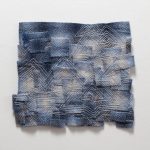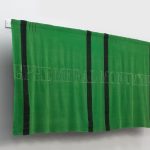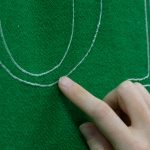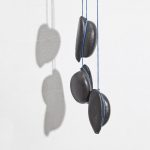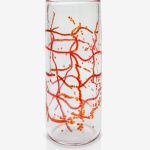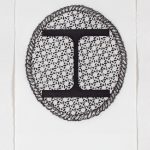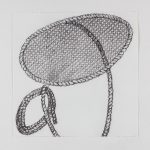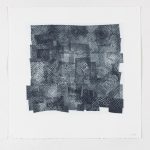This content was published: March 27, 2019. Phone numbers, email addresses, and other information may have changed.
Marie Watt – Artifact
Rock Creek Helzer Gallery
- April 1 – May 14, 2019
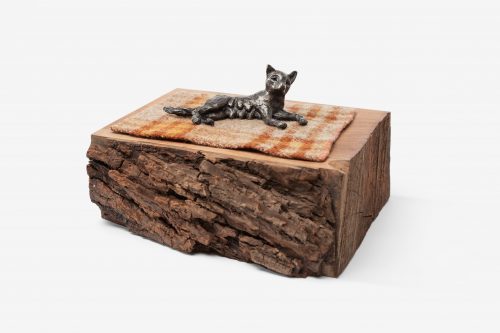
- Artist talk and gallery reception: May 1, 11am-12 noon
- Gallery hours:
- Monday – Friday 9am-5pm
- Saturday 9:30am-4:30pm (free parking!)
Marie Watt’s illustrious career is grounded in and inspired by her heritage. As the daughter of a Seneca mother and Scotch/German Father, Watt’s interests lie in investigations of family, place, tradition, and community. The works included in Artifact at the Helzer Gallery intertwine Native American traditions and their connection to community, three generations of the artist’s family, and the larger world of economic trade and colonial history.
Watt’s work is not didactic. It does not preach. Rather, Watt imbues culturally significant objects and materials with a kind of question. Who am I? Who are we? In the series, Portrait with Chair Caning, she asks ‘how do I represent myself’? By combining imagery associated with her grandfather (chair caning) with that of her white rancher father (lasso) the image becomes a surrogate for the artist’s dualistic heritage. In a second work from the series, the I-beam associated with Native Americans’ connections to the ironworking trade, is emblazoned over chair caning, declaratively stating that “I” is for I – me.
Blankets and beads play a large role in the questions that Watt asks. As cultural signifiers the blankets and beads speak to interpersonal relationships, trade, and the body. Czech beads have been manufactured on the same equipment for over 200 years. Because of this continuous history, the beads that Watt uses share a material space with the history of European textiles and colonial trade between the Hudson Bay Trading Co. and indigenous peoples of the Americas. In the series In(compatibility), Watt materially investigates the compatibility of cultures as the red Czech glass beads struggle to fuse with clear glass, creating artifacts of this tension in the materiality of the vessels.
Placeholder also holds a subtle tension. Blankets are an important part of Native American trade. They are given as gifts at important times in life, provide warmth and wrap newborns and the dying alike. Watt’s use of a reclaimed trade blanket directly links Placeholder to the body and history, while her use of Czech trade beads connects to larger cultural forces and literally spells out the temporal and fleeting quality of both the personal and cultural aspects of the human experience. It is important to note that Placeholder was beaded with the help of others. Shared events, such as sewing circles and the like, are a cornerstone of Watt’s work, and bring shared experience, storytelling and community building to the fore.
It is also important to note that Watt does not necessarily deploy traditional Native American aesthetics in her work. Rather, significant objects, images, and materials are processed through her exploration of and education in the wider field of Visual Arts (Willamette University, Yale, and The Institute of American Indian Arts in Sante Fe). The intertwining of references to abstraction, the history of Art and monuments, and her interest in life as Art work alongside the meaningful stuff of Watt’s life and culture to ask the important questions- ‘who am I now? who are we now?’. As the artist stated in conversation with Rebecca J. Dobkins, “Tradition is not static, but a living force that we have a responsibility to nurture and cultivate.”[1]
Marie Watt lives in Portland, Oregon and Brooklyn, New York. Her work is in the collections of the Albright-Knox Gallery, Denver Art Museum, National Gallery of Canada, Smithsonian American Art Museum, as well as the US Embassies of Ghana and Pakistan. Watt’s work has been exhibited extensively, including at the Portland Art Museum, Seattle Art Museum, Jordan Schnitzer Museum of Art, Hallie Ford Museum of Art, and is currently on view at the Honolulu Biennial. Watt is represented by PDX Contemporary Art in Portland, Oregon and Greg Kucera Gallery in Seattle, Washington.
[1] Marie Watt: Lodge, Rebecca J. Dobkins, Hallie Ford Museum of Art – Willamette University, 2012

